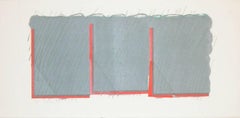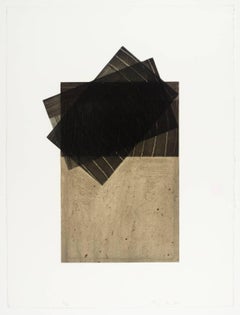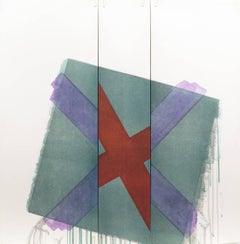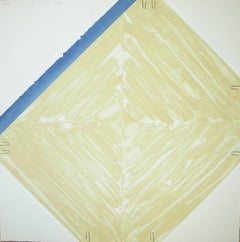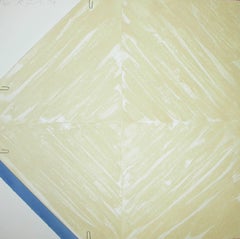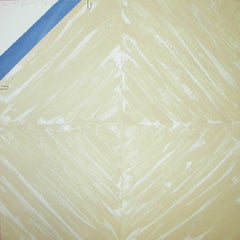Richard Smith Art
English, 1931-2016
Charles Richard "Dick" Smith was an English printmaker and painter.
He Attended St Albans School of Art followed by post-graduate studies at the Royal College of Art, London, from 1954-57. Smith shared a flat-cum-studio with Peter Blake in his second year at the RCA, and then again for two years after he left the college in 1957. When Terence Conran's Soup Kitchen opened on Fleet Street in the late 1950s, it featured a letter-collage mural by Smith and Blake. Michael Chow would later commission Smith to design installations for his restaurant in Los Angeles, and Chow and Conran have remained two of his biggest supporters.
In 1959 he moved to New York to teach on a Harkness Fellowship, staying for two years, where he produced paintings combining the formal qualities of many of the American abstract painters which made references to American commercial culture. The artist's first solo exhibition was at the Green Gallery. As his work matured it tended to be more minimal, often painted using one colour with a second only as an accent.
In trying to find ways of transposing ideas, Smith began to question the two-dimensional properties of art itself and to find ways by which a painting could express the shape of reality as he saw it. These principles he carried into his graphic work by introducing cut, folded and stapled elements into his prints; some works were multi-leaved screenprinting, and others printed onto three-dimensional fabricated metal.
Smith returned to England in 1963 - specifically East Tytherton, Wiltshire where Howard Hodgkin was a neighbour - and gained critical acclaim for extending the boundaries of painting into three dimensions, creating sculptural shaped canvases with monumental presence, which literally protruded into the space of the gallery. Evocative titles such as Panatella and Revlon, and cosmetic, synthetic colours alluded to the consumer landscapes of urban America which had proved so influential. He showed at the Kasmin Gallery, a venture between Kas and the Marquess of Dufferin and Ava in New Bond Street, throughout the 60s, more-widely known as David Hockney's first gallery.
Smith was invited to exhibit at the XXXV Venice Biennale as the official British artist in 1970. Smith taught with Richard Hamilton at Gateshead in 1965, where he met Mark Lancaster and Stephen Buckley, and again in 2000, becoming close to the artist and his wife, Terry.
By the late 1960s Smith's ambition to produce paintings which shared a common sensibility with other media, such as film and photography, began to wane and he focused on the formal qualities of painting. First exhibited in New York in 1971, the traditional wooden supports of the canvases were replaced by aluminium rods and strings, allowing them to be hung freely in response to the surrounding architecture. Smith continued in the subsequent decades to construct site-specific works in public and private spaces often hanging from the ceilings or architectural supports. He resettled in Patchogue, New York in around 1977.
Smith was awarded the CBE in 1971.to
2
17
9
40
11
4
Overall Width
to
Overall Height
to
76
5
3
58
8
2
66
5
3
2
1
32
23
19
1
1
1
1
1
1
1
1
36
30
8
7
5
81
8,230
2,806
1,652
1,318
8
3
69
12
Artist: Richard Smith
Horizon II (Grey and Orange)
By Richard Smith
Located in London, GB
Edition of 75, Set of 6
33 x 71 cms (13 x 28 ins)
Category
1970s Abstract Richard Smith Art
Materials
Lithograph
Drawing Boards II (No.2)
By Richard Smith
Located in London, GB
Edition of 30, Set of 5
74.9 x 59.1 cms (29 1/2 x 23 1/4 ins)
Category
1980s Abstract Richard Smith Art
Materials
Etching
Two of a Kind VIb (dark red x on green)
By Richard Smith
Located in London, GB
70 x 72 cms (27 1/2 x 28 1/2 ins)
Edition of 70
Category
1970s Abstract Richard Smith Art
Materials
Color, Lithograph
Paperclip suite IIe
By Richard Smith
Located in London, GB
Edition of 25
45 x 45 cms (17.5 x 17.5 ins)
Category
1970s Abstract Richard Smith Art
Materials
Etching
Paperclip Suite IIb (yellow / blue)
By Richard Smith
Located in London, GB
Edition of 25
45 x 45 cms (17.5 x 17.5 ins)
Category
1970s Abstract Richard Smith Art
Materials
Etching
Paperclip Suite II (yellow / blue)
By Richard Smith
Located in London, GB
Etching, Edition of 25
45 x 45 cms (17.5 x 17.5 ins)
Category
1970s Abstract Richard Smith Art
Materials
Etching
Paperclip Suite IIc (yellow/blue)
By Richard Smith
Located in London, GB
Etching, Edition of 25
45 x 45 cms (17.5 x 17.5 ins)
Category
1970s Abstract Richard Smith Art
Materials
Etching
Paperclip Suite I (brown)
By Richard Smith
Located in London, GB
Edition of 25
44.5 x 44.5 cms (17 1/2 x 17 1/2 ins)
Category
1970s Abstract Richard Smith Art
Materials
Etching
Paperclip Suite I (brown)
By Richard Smith
Located in London, GB
Edition of 25
44.5 x 44.5 cms (17 1/2 x 17 1/2 ins)
Category
1970s Abstract Richard Smith Art
Materials
Etching
Russian II (red)
By Richard Smith
Located in London, GB
Edition of 50
51 x 51 cms (20 x 20 ins)
Category
1970s Abstract Richard Smith Art
Materials
Etching
Paperclip Suite I (brown)
By Richard Smith
Located in London, GB
Edition of 25
44.5 x 44.5 cms (17 1/2 x 17 1/2 ins)
Category
1970s Abstract Richard Smith Art
Materials
Etching
Paperclip Suite I (brown)
By Richard Smith
Located in London, GB
Edition of 25
44.5 x 44.5 cms (17 1/2 x 17 1/2 ins)
Category
1970s Abstract Richard Smith Art
Materials
Etching
Russian I (black)
By Richard Smith
Located in London, GB
Edition of 50
51 x 51 cms (20 x 20 ins)
Category
1970s Abstract Richard Smith Art
Materials
Etching
Two of a Kind IVa (red x on lavender)
By Richard Smith
Located in London, GB
70.5 x 70 cms (27 3/4 x 27 1/2 ins)
Edition of 80
Category
1970s Abstract Richard Smith Art
Materials
Color, Etching
Two of a Kind IIIa (bright red x on green)
By Richard Smith
Located in London, GB
100.7 x 46.3 cms (40 x 18 1/4 ins)
Edition of 90
Category
1970s Abstract Richard Smith Art
Materials
Color, Lithograph
Drawing (Green with Three Tongues) Pastel on Cutout Paper by Richard Smith, 1970
By Richard Smith
Located in Kingsclere, GB
Drawing (Green with Three Tongues), Pastel on CutOut Paper by Richard Smith, 1970
Additional information:
Medium: Pastel on Cut-out Paper with Staples
99 x 143 cm
39 x 56 1/4 in
Signed and dated
Smith was a key figure in the British development of Pop Art. By 1970 when this work was executed, Smith was primarily concerned with the examination of the two-dimensional nature of painting and was experimenting in both his oils and his works on paper with extending the paint surface out into a three-dimensional space. In this work we see the added extensions in collage (the ‘three tongues’) to the normal rectangular format. The large scale is testament to the influence of advertising in Smith's late 60s and early 70s works. This work was made in the same year that Richard Smith represented Great Britain at the XXXV Venice Biennale, with a solo show in the British Pavilion. Smith was chosen by a committee of art experts, who were Director of Tate Norman Reid, art historian Alan Bowness, art collector David Thompson, the British Council’s Lilian Somerville and art historian Norbert Lynton. It was a hugely defining period in Smith's career, including the creation of his sculpture-cum-paintings 'Waterfall', 'Triangular' (both in the collection of Tate, London) and Sphinx Series (British Council), before he began developments towards his Kite Series in 1971.
Charles Richard "Dick" Smith was an English printmaker and painter.
Smith was born in Letchworth, Hertfordshire, to Doris (née Chandler), a nurse and daughter of a chemical company director. He studied at Hitchin Grammar School and Luton School of Art. After military service with the Royal Air Force in Hong Kong, he attended St Albans School of Art followed by post-graduate studies at the Royal College of Art, London, from 1954-57. Smith shared a flat-cum-studio with Peter Blake in his second year at the RCA, and then again for two years after he left the college in 1957. When Terence Conran's Soup Kitchen opened on Fleet Street in the late 1950s, it featured a letter-collage mural by Smith and Blake. Michael Chow would later commission Smith to design installations for his restaurant in Los Angeles, and Chow and Conran have remained two of his biggest supporters.
In 1959 he moved to New York to teach on a Harkness Fellowship, staying for two years, where he produced paintings combining the formal qualities of many of the American abstract painters which made references to American commercial culture. The artist's first solo exhibition was at the Green Gallery. As his work matured it tended to be more minimal, often painted using one colour with a second only as an accent.
In trying to find ways of transposing ideas, Smith began to question the two-dimensional properties of art itself and to find ways by which a painting could express the shape of reality as he saw it. He began to take the canvas off the stretcher, letting it hang loose, or tied with knots, to suggest sails or kites - objects which could change with new directions rather than being held rigid against a wall, and taking painting close to the realm of sculpture. These principles he carried into his graphic work by introducing cut, folded and stapled elements into his prints; some works were multi-leaved screenprinting, and others printed onto three-dimensional fabricated metal.
Smith returned to England in 1963 - specifically East Tytherton, Wiltshire where Howard Hodgkin was a neighbour - and gained critical acclaim for extending the boundaries of painting into three dimensions, creating sculptural shaped canvases with monumental presence, which literally protruded into the space of the gallery. Evocative titles such as Panatella and Revlon, and cosmetic, synthetic colours alluded to the consumer landscapes of urban America which had proved so influential. He showed at the Kasmin Gallery, a venture between Kas and the Marquess of Dufferin and Ava in New Bond Street, throughout the 60s, more-widely known as David Hockney's first gallery.
After being awarded the Grand Prize at the 9th São Paulo Biennial in 1967 and important exhibitions at Kasmin in 1963, Tate in 1964, and Richard Feigen Gallery in 1966, Smith was invited to exhibit at the XXXV Venice Biennale as the official British artist in 1970. Smith was chosen by a committee of art experts, who were Director of Tate Norman Reid, art historian Alan Bowness, art collector David Thompson, the British Council’s Lilian Somerville and art historian Norbert Lynton. Smith taught with Richard Hamilton at Gateshead in 1965, where he met Mark Lancaster and Stephen Buckley, and again in 2000, becoming close to the artist and his wife, Terry.
By the late 1960s Smith's ambition to produce paintings which shared a common sensibility with other media, such as film and photography, began to wane and he focused on the formal qualities of painting. The freestanding installation Gazebo exhibited at the Architectural League of New York in 1966, and a tent project at the Aspen Design...
Category
20th Century Richard Smith Art
Materials
Pastel
'Nesting Woodcock' Bronze Animal Wildlife Sculpture of a bird nesting greenery
By Richard Smith
Located in Shrewsbury, Shropshire
'Nesting Woodcock' by Richard Smith is a beautiful contemporary bronze sculpture. Beautiful patina and incredible detail. Sure to make an amazing addition to any collection!
Rich...
Category
21st Century and Contemporary Contemporary Richard Smith Art
Materials
Bronze
'Cockerel' Bronze Animal Sculpture of a Brown Cockerel. Farm wildlife sculpture
By Richard Smith
Located in Shrewsbury, Shropshire
'Cockerel' is a Bronze sculpture full of personality. Richard Smith conveys so much character in such simple lines, exemplifying a truly wonderful talent. The fantastic richly detail...
Category
21st Century and Contemporary Contemporary Richard Smith Art
Materials
Bronze
'Parasol Mushroom' Contemporary bronze sculpture of a mushroom, Wildlife
By Richard Smith
Located in Shrewsbury, Shropshire
'Parasol Mushroom' is a stunningly elegant Bronze sculpture of a beautiful mushroom in the British countryside. Richard Smith conveys so much detail in such simple lines, exemplifyin...
Category
21st Century and Contemporary Contemporary Richard Smith Art
Materials
Bronze
'Shaggy Ink Cap Mushroom' Contemporary bronze sculpture of a British Mushroom
By Richard Smith
Located in Shrewsbury, Shropshire
'Shaggy Ink Cap Mushroom' is a stunningly elegant Bronze sculpture of a British Mushroom in Nature. The patina you see is what makes this piece so lifelike, rarely seen in bronze tod...
Category
21st Century and Contemporary Contemporary Richard Smith Art
Materials
Bronze
'Arctic Hare' Contemporary Bronze Animal Sculpture of a hare. Patinated White
By Richard Smith
Located in Shrewsbury, Shropshire
'Arctic Hare' is a stunningly elegant Bronze sculpture. Richard Smith conveys so much character in such simple lines, exemplifying a truly wonderful talent. The fantastic richly deta...
Category
21st Century and Contemporary Contemporary Richard Smith Art
Materials
Bronze
Richard Smith art for sale on 1stDibs.
Find a wide variety of authentic Richard Smith art available for sale on 1stDibs. If you’re browsing the collection of art to introduce a pop of color in a neutral corner of your living room or bedroom, you can find work that includes elements of orange, green, blue and other colors. You can also browse by medium to find art by Richard Smith in etching, lithograph, screen print and more. Much of the original work by this artist or collective was created during the 20th century and is mostly associated with the abstract style. Not every interior allows for large Richard Smith art, so small editions measuring 5 inches across are available. Customers who are interested in this artist might also find the work of Antoni Clavé, Risaburo Kimura, and Pierre Muckensturm. Richard Smith art prices can differ depending upon medium, time period and other attributes. On 1stDibs, the price for these items starts at $216 and tops out at $11,500, while the average work can sell for $1,002.
